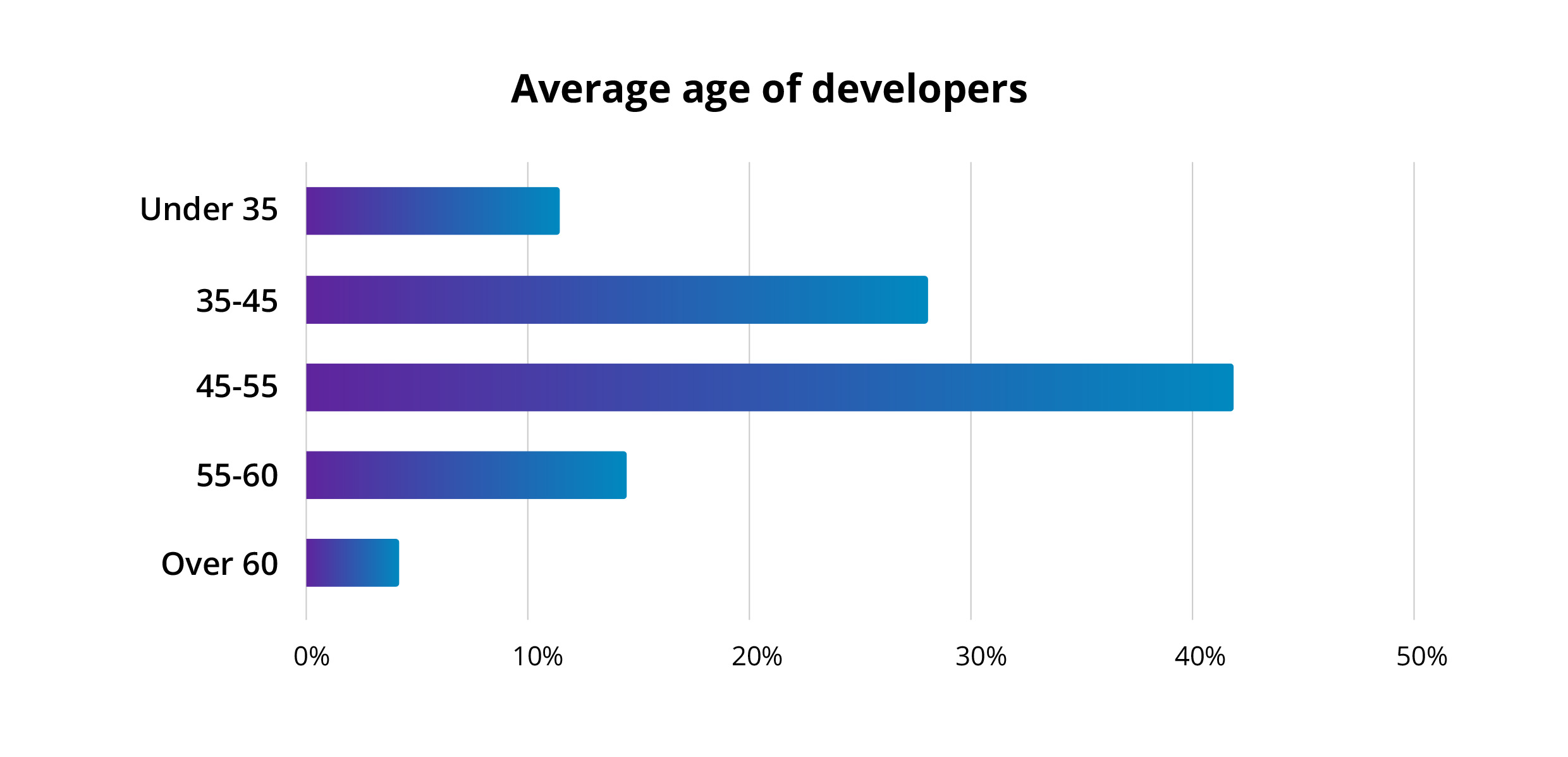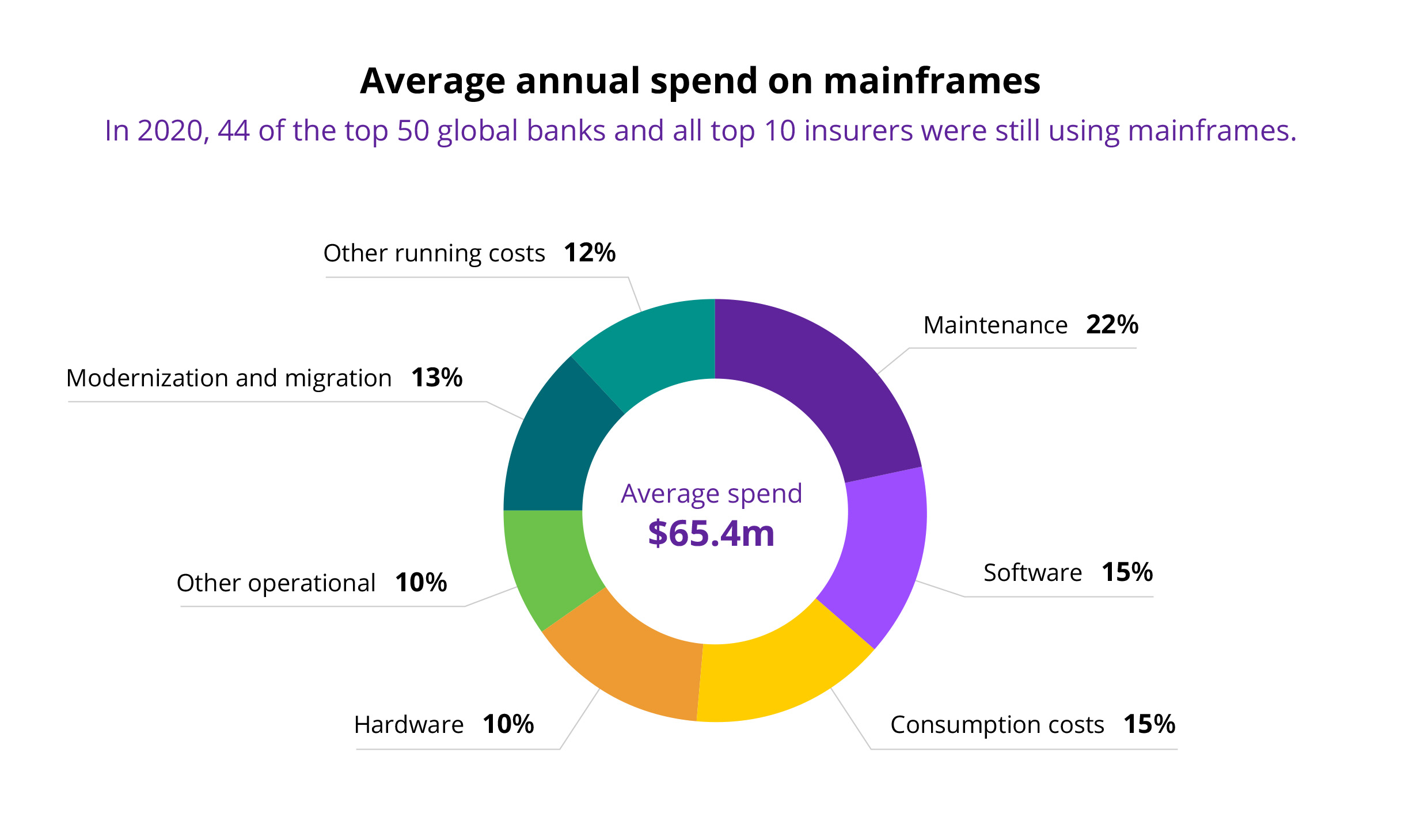In brief
- According to Forrester, most banking professionals (74%) view mainframes as long-term strategic platforms despite reports that they’re being discarded in favor of cloud-based services and adverse perceptions about the technology
- Skills gaps are forcing enterprises to look elsewhere for COBOL know-how. Although the situation is improving, qualified mainframe engineers, developers and consultants are relatively few and far between
- IBM has initiated several COBOL fellowships and training programs for budding IT professionals that have trained more than 180,000 developers over a dozen or more years
So, what is core banking exactly?
Gartner defines a core banking system as “a back-end system that processes daily banking transactions and posts updates to accounts and other financial records. Core banking systems typically include deposit, loan and credit processing capabilities, with interfaces to general ledger systems and reporting tools.”
Simple enough.
Or it would be if banks didn’t have to cope with the fact that, according to Reuters, 43% of the core banking systems in the United States are built on the common business-oriented language (COBOL), a language that predates Coke cans, computer mice and The Beatles. In fact, 95% of ATM swipes, 80% of in-person transactions and multiple 40-50-year-old U.S. federal government systems also rely on the 220 billion lines of COBOL still in use today.
But what happens if something goes wrong or you need an update?
“Who ya gonna call?”
Cobolbusters? Good luck with that, then. Unfortunately, most engineers who created and worked on these heritage systems retired long ago, taking crucial knowledge and expertise with them. In 2017, Reuters reported that COBOL programmers were most likely to be between 45-55 years old.

And although there’s been an uptick in young developers schooled in COBOL since then, there’s just not enough know-how to go around.
Why is modernizing heritage systems so complex?
The problem is that new and relatively simple transaction and balance-holding systems have to connect with ancient system architectures that have been continually patched to meet changing business needs. Of course, banking executives and customers never get to see this part of the technology stack. So, a culture of “If the back-end’s not broke, don’t fix it” has developed, especially bearing in mind the considerable risk, expense and timescale involved (it could take years.)

- Companies claim they’re spending an average of $65 million annually. One-fifth is swallowed up by maintenance alone
- As the price of cloud infrastructure is decreasing, mainframe licensing and staffing costs are increasing, pressuring most companies into making a change
What else is driving the need for modernization?
- Pressure to reduce IT OPEX and CAPEX
- Changing business demand improved agility and speed
- Continuity and resiliency of business operations must be maintained
- Operations have to remain secure and compliant
- Talent shortage and skills gap challenges
- Capacity and operations need to be able to scale rapidly
- Compliance, risk and governance must keep up to date
- Faster time to market is a perennial success factor
Lead from the front with Zoreza Global Mainframe Engineering Services
Zoreza Global helps clients run, maintain and transform existing mission-critical mainframe applications by drawing on 5 decades’ worth of mainframe application experience and a deep understanding of mission-critical systems and operations. We know what it takes to create sustainable enterprise change, resolve cultural and process challenges, and rationalize the business implications.

- Three-quarters of professionals (74%) view mainframes as long-term strategic platforms, in spite of adverse perceptions about the technology
- Most respondents denied planning to retire their mainframe, and nearly 80% reckoned mainframes were thought to be modern (or mature)
- Most participants said mainframes will never disappear despite reports that mainframes are being discarded in favor of cloud-based services
Our experts have all the tools to operate and maintain existing environments while enabling transformation and modernization strategies across the entire client lifecycle, from advisory and execution to run.
Zoreza Global Mainframe Engineering Services enable run- and change-the-bank application development and testing through Agile and waterfall delivery methods, including:
- Project management
- Requirement definition
- Design: Functional and technical
- Development: Unit
- Testing: Unit, system and integration
- Independent verification and validation, QA
- Testing automation
- Migration to production
- Production support
- Project reporting and control

“COBOL isn’t all bad”
IBM, manufacturer of mainframe computers that run on COBOL, maintains that the future is not as black as it’s painted. The company has initiated several COBOL fellowships and training programs for budding IT professionals. These programs have trained more than 180,000 developers over a dozen or more years. However, COBOL veterans reckon it takes more than just knowing the language to succeed in the long run. COBOL-based systems differ significantly, and as veteran programmers rarely wrote user guides, troubleshooting can be a highly complex business.
So, how has COBOL survived?
The truth is, COBOL is a high-level, procedural programming language for business applications. It was developed to fix complex business processes and data processing as a standardized, efficient and readable language. COBOL has powered mission-critical systems in finance, insurance, health care, government and many other industries. Rigorous syntax and error-checking capabilities have helped COBOL programs withstand multiple updates and adaptations without endangering system integrity and run relentlessly for decades.
The vintage language's reliable efficiency makes it the perfect choice for handling extensive data-processing tasks. The fixed-format syntax optimizes code generation, enabling COBOL execution with minimal overhead. Also, COBOL's comprehensive file handling and indexed access support facilitate rapid data retrieval, returning superior batch-processing performance levels.
It’s scalable and extremely flexible
Being highly scalable, banks can rely on COBOL to handle expanding datasets and complex business logic accurately and consistently. Its flexibility, modular programming and easy interfacing with other languages and systems perfectly integrate heritage applications with contemporary and emerging technologies.
In industries where data security is vital, COBOL's resilient design enforces strict data typing rules and extensive data validation processes, mitigating the risk of data corruption and security breaches. It also ensures transaction atomicity and consistency, protecting sensitive information in critical systems.
Backward compatibility, which allows for seamless migration and integration of existing systems with modern platforms, makes COBOL the perfect solution for businesses that want to modernize their infrastructure with minimal disruption. It’s now regarded as a crucial asset for banks aiming to build or rebuild resilient systems to stand the test of time.
Possible drawbacks of maintaining heritage systems
Consequences of not modernizing
The general feeling is that working on existing mission-critical systems increases the risk of downtime.

While security, cloud working and software licensing costs polled the most votes in the survey, there were other drivers, too:
- Integration issues (26%), organizational technology consolidation (25%), hardware dependency (23%), and lack of scalability (19%) reflect increasing platform-specific challenges as the rift between existing mission-critical systems and cloud migration widens
- Most participants (41%) believed that retaining heritage systems increased the risk of downtime
- The inability to scale to meet new demands (34%), a lack of business agility (32%) and the difficulty of integrating with modern tech (32%) also concerned advocates
Five benefits of partnering with Zoreza Global
1. Access to one of the world’s largest mainframe engineering talent pools
2. Industry-leading tools and automation
3. Reduced risk and existing mission-critical platform maintenance costs
4. Outsourcing of run- or change-the-bank services
5. Access to an ecosystem of other products and services that work with COBOL and customer information control system (CICS) applications
And by the way, we’ve done this before
Financial services group: Provided mainframe developers to analyze and stabilize the group’s core application after assisting their internal resources with a production outage.
Major global bank: Supplied more than 35 Hogan mainframe developers from the United States and India to enable greater productivity against the bank’s development backlog.
Well-established U.S. bank: Deployed a blended team (the United States and India) to provide 24/7 primary production support for both Hogan and non-Hogan (mainframe) applications.
Resource management
- Global resource pool
- Proven approach to recruitment and retention
- Academies and training programs to sustain and grow talent
- The core/flex model allows teams to scale up and down rapidly according to fluctuating requirements
Mainframe expertise
- Largest financial services mainframe practice in the world
- 40 years of experience in developing and supporting mission-critical mainframe systems within financial services
- Hogan’s development is deeply rooted in COBOL and mainframe technology
- IBM partners for decades
- Expertise in mainframe tools and technologies

Outcomes
Partnering with Zoreza Global Mainframe Engineering Services enables financial institutions to modernize their existing mission-critical platforms while positioning internal teams to execute modernization and transformation strategies.
Engaging Zoreza Global significantly de-risks the transformational process by reducing the changes needed and ensuring the continuity of skilled staff, developing and supporting the banking platform. It also allows the bank to drive down costs by using emerging technologies and leveraging our global resource pool.
In short
The mainframe will be with us for some time yet. It’s a fundamental element of forward-looking, cross-industry, mainframe hybrid-cloud strategies and environments:
- Although developed over 60 years ago, over 40% of banks still use the COBOL programming language as the core technology of their banking systems. IBM is committed to keeping COBOL evergreen (e.g., allowing COBOL and Java to run together on mainframes to capitalize on contemporary products like Z/Series, DB2, etc., and developing object-oriented code to complement its time-honored existing mission-critical code.)
- Mainframe appeal and investment are growing in step with enterprise validation of its purpose, support and tried-and-tested workload management
- Mainframe security is unparalleled. With the potential cyber risks to new platforms and applications, the resilience, transaction management and data safety mainframes provide is vital. Similarly, pervasive encryption and passports offer comprehensive compliance and control for both mobile and resting data
- Skills gaps are forcing enterprises to look elsewhere for know-how. Although the situation is improving, qualified mainframe engineers, developers and consultants are hard to come by
Let’s talk mainframes
If you’d like to find out more about what Zoreza Global’s experience and technology could do for your organization — including what to do about sourcing programmers with appropriate and proven unicorn skills and knowledge — visit our website or contact us.









